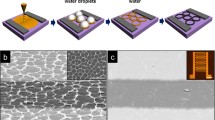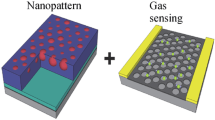Abstract
Arrays of chemical vapor sensors based on graphene field effect transistors functionalized with single-stranded DNA have been demonstrated. Standard photolithographic processing was adapted for use on large-area graphene by including a metal protection layer, which protected the graphene from contamination and enabled fabrication of high quality field-effect transistors (GFETs). Processed graphene devices had hole mobilities of 1,640 ± 250 cm2·V−1·s−1 and Dirac voltages of 15 ± 10 V under ambient conditions. Atomic force microscopy was used to verify that the graphene surface remained uncontaminated and therefore suitable for controlled chemical functionalization. Single-stranded DNA was chosen as the functionalization layer due to its affinity to a wide range of target molecules and π-π stacking interaction with graphene, which led to minimal degradation of device characteristics. The resulting sensor arrays showed analyte- and DNA sequence-dependent responses down to parts-per-billion concentrations. DNA/GFET sensors were able to differentiate among chemically similar analytes, including a series of carboxylic acids, and structural isomers of carboxylic acids and pinene. Evidence for the important role of electrostatic chemical gating was provided by the observation of understandable differences in the sensor response to two compounds that differed only by the replacement of a (deprotonating) hydroxyl group by a neutral methyl group. Finally, target analytes were detected without loss of sensitivity in a large background of a chemically similar, volatile compound. These results motivate further development of the DNA/graphene sensor family for use in an electronic olfaction system.

Similar content being viewed by others
References
Reina, A.; Jia, X. T.; Ho, J.; Nezich, D.; Son, H. B.; Bulovic, V.; Dresselhaus, M. S.; Kong, J. Large area, few-layer graphene films on arbitrary substrates by chemical vapor deposition. Nano Lett. 2009, 9, 30–35.
Li, X. S.; Cai, W. W.; An, J.; Kim, S.; Nah, J.; Yang, D. X.; Piner, R.; Velamakanni, A.; Jung, I.; Tutuc, E., et al. Large-area synthesis of high-quality and uniform graphene films on copper foils. Science 2009, 324, 1312–1314.
Luo, Z. T.; Lu, Y.; Singer, D. W.; Berck, M. E.; Somers, L. A.; Goldsmith, B. R.; Johnson, A. T. C. Effect of substrate roughness and feedstock concentration on growth of wafer-scale graphene at atmospheric pressure. Chem. Mater. 2011, 23, 1441–1447.
Pirkle, A.; Chan, J.; Venugopal, A.; Hinojos, D.; Magnuson, C. W.; McDonnell, S.; Colombo, L.; Vogel, E. M.; Ruoff, R. S.; Wallace, R. M. The effect of chemical residues on the physical and electrical properties of chemical vapor deposited graphene transferred to SiO2. Appl. Phys. Lett. 2011, 99, 122108.
Kumar, S.; Peltekis, N.; Lee, K.; Kim, H. Y.; Duesberg, G. S. Reliable processing of graphene using metal etchmasks. Nanoscale Res. Lett. 2011, 6, 390.
Ishigami, M.; Chen, J. H.; Cullen, W. G.; Fuhrer, M. S.; Williams, E. D. Atomic structure of graphene on SiO2. Nano Lett. 2007, 7, 1643–1648.
Ohno, Y.; Maehasi, K.; Matsumoto, K. Label-free biosensors based on aptamer-modified graphene field-effect transistors. J. Am. Chem. Soc. 2010, 132, 18012–18013.
Dan, Y. P.; Lu, Y.; Kybert, N. J.; Luo, Z. T.; Johnson, A. T. C. Intrinsic response of graphene vapor sensors. Nano Lett. 2009, 9, 1472–1475.
Lu, Y.; Goldsmith, B. R.; Kybert, N. J.; Johnson, A. T. C. DNA-decorated graphene chemical sensors. Appl. Phys. Lett. 2010, 97, 083107.
Safron, N. S.; Kim, M.; Gopalan, P.; Arnold, M. S. Barrier-guided growth of micro- and nano-structured graphene. Adv. Mater. 2012, 24, 1041–1045.
Burg, B. R.; Poulikakos, D. Large-scale integration of single-walled carbon nanotubes and graphene into sensors and devices using dielectrophoresis: A review. J. Mater. Res. 2011, 26, 1561–1571.
Li, P. F.; Lei, N.; Xu, J.; Xue, W. High-yield fabrication of graphene chemiresistors with dielectrophoresis. IEEE T. Nanotechnol. 2012, 11, 751–759.
Liang, X. L.; Sperling, B. A.; Calizo, I.; Cheng, G. J.; Hacker, C. A.; Zhang, Q.; Obeng, Y.; Yan, K.; Peng, H. L.; Li, Q. L., et al. Toward clean and crackless transfer of graphene. ACS Nano 2011, 5, 9144–9153.
Goossens, A. M.; Calado, V. E.; Barreiro, A.; Watanabe, K.; Taniguchi, T.; Vandersypen, L. M. K. Mechanical cleaning of graphene. Appl. Phys. Lett. 2012, 100, 073110.
Nagashio, K.; Yamashita, T.; Nishimura, T.; Kita, K.; Toriumi, A. Electrical transport properties of graphene on SiO2 with specific surface structures. J. Appl. Phys. 2011, 110, 024513.
Liao, L.; Bai, J. W.; Qu, Y. Q.; Lin, Y. C.; Li, Y. J.; Huang, Y.; Duan, X. F. High-κ oxide nanoribbons as gate dielectrics for high mobility top-gated graphene transistors. Proc. Natl. Acad. Sci. U. S. A. 2010, 107, 6711–6715.
Lerner, M. B.; Resczenski, J. M.; Amin, A.; Johnson, R. R.; Goldsmith, J. I.; Johnson, A. T. C. Toward quantifying the electrostatic transduction mechanism in carbon nanotube molecular sensors. J. Am. Chem. Soc. 2012, 134, 14318–14321.
Kybert, N. J.; Lerner, M. B.; Yodh, J. S.; Preti, G.; Johnson, A. T. C. Differentiation of complex vapor mixtures using versatile DNA-carbon nanotube chemical sensor arrays. ACS Nano 2013, 7, 2800–2807.
Staii, C.; Johnson, A. T.; Chen, M.; Gelperin, A. DNA-decorated carbon nanotubes for chemical sensing. Nano Lett. 2005, 5, 1774–1778.
Hill, A. The possible effects of the aggregation of the molecules of hemoglobin on its oxygen dissociation curve. J. Physiol. 1910, 40, 4–7.
Abboud, J. L. M.; Notario, R. Critical compilation of scales of solvent parameters. Part I. Pure, non-hydrogen bond donor solvents. Pure Appl. Chem. 1999, 71, 645–718.
Gao, L. B.; Ren, W. C.; Xu, H. L.; Jin, L.; Wang, Z. X.; Ma, T.; Ma, L. P.; Zhang, Z. Y.; Fu, Q.; Peng, L. M., et al. Repeated growth and bubbling transfer of graphene with millimetresize single-crystal grains using platinum. Nat. Commun. 2012, 3, 699.
Khamis, S. M.; Jones, R. A.; Johnson, A. T. C. Optimized photolithographic fabrication process for carbon nanotube devices. AIP Adv. 2011, 1, 022106.
Author information
Authors and Affiliations
Corresponding author
Electronic supplementary material
Rights and permissions
About this article
Cite this article
Kybert, N.J., Han, G.H., Lerner, M.B. et al. Scalable arrays of chemical vapor sensors based on DNA-decorated graphene. Nano Res. 7, 95–103 (2014). https://doi.org/10.1007/s12274-013-0376-9
Received:
Revised:
Accepted:
Published:
Issue Date:
DOI: https://doi.org/10.1007/s12274-013-0376-9




